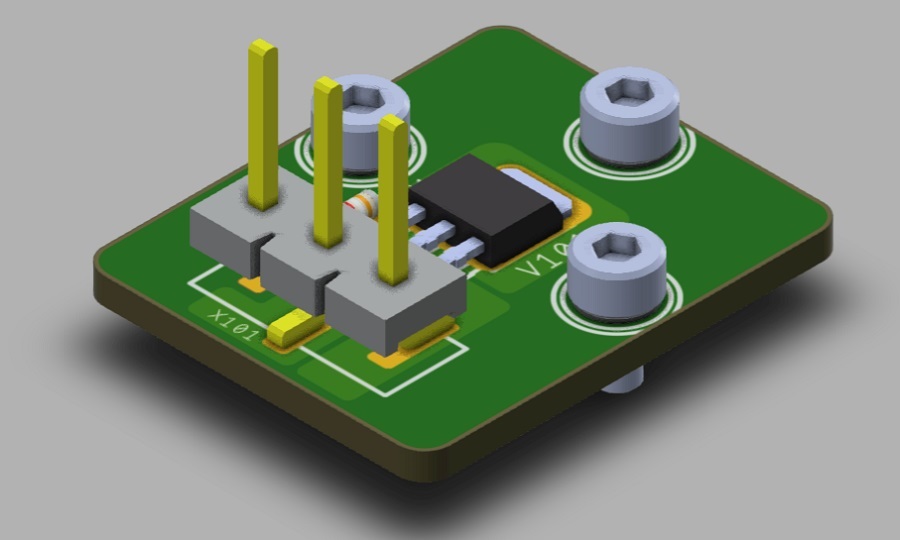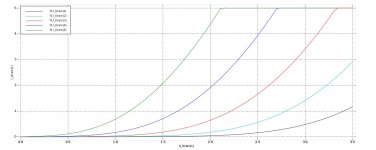Waiting for the parts to show up.
Decided on final curve tracer configuration. 6V, 3A capability. sub milli-volt resolution.
The LU1014D datasheet has Vth (Vpinch) defined as the voltage where Ids is 250 uA at Vds = 0.1v. I will be using Vds = 2.4v which is the Vds in the First Watt F3.
Vgs is the voltage where Ids is 1.5A which is the bias current of the First Watt F3 amplifier.
I have written a script that automatically characterizes Vpinch followed by Vgs. Repeatability is ~ 2mV.
My sample device from my stash has Vpinch = -1.460v and Vgs = -0.904v.
Transconductance is not as repeatable as Vpinch and Vgs as transconductance is the slope of the line tangent to the bias point on the Vgs-Id curve.
How closely pairs will match will depend on the distribution of the parameters in the population of devices.
Decided on final curve tracer configuration. 6V, 3A capability. sub milli-volt resolution.
The LU1014D datasheet has Vth (Vpinch) defined as the voltage where Ids is 250 uA at Vds = 0.1v. I will be using Vds = 2.4v which is the Vds in the First Watt F3.
Vgs is the voltage where Ids is 1.5A which is the bias current of the First Watt F3 amplifier.
I have written a script that automatically characterizes Vpinch followed by Vgs. Repeatability is ~ 2mV.
My sample device from my stash has Vpinch = -1.460v and Vgs = -0.904v.
Transconductance is not as repeatable as Vpinch and Vgs as transconductance is the slope of the line tangent to the bias point on the Vgs-Id curve.
How closely pairs will match will depend on the distribution of the parameters in the population of devices.
Started characterizing my stash of LU1014D. There are a decent percentage that will make matched pairs.
The spread of Vgs so far is -0.6 to -1.2. The value of source resistor to use for an F3 is approximately Vgs / 1.5. This is a room temperature calculation. At operating temp, an adjustment will likely have to be made.
The spread of Vgs so far is -0.6 to -1.2. The value of source resistor to use for an F3 is approximately Vgs / 1.5. This is a room temperature calculation. At operating temp, an adjustment will likely have to be made.
Working my way through my stash of LU1014. Some of the parts appear to be shorted until I placed a 10k resistor in series with the gate. My guess is that the parts are oscillating and then latching up. I have seen this latchup behavior with the IXYS MOSFET hockey pucks.
There are a small number that appear to be actually shorted. That signals to me that there is no quality control in the supply chain. No surprise.
If you want to use these eBay parts, you need to test every one for a short that you want to use.
To me, the price of the eBay parts makes it worth the effort to characterize all the parts and weed out the bad parts.
With a source resistor setting the bias point at a much lower gain, I think the parts will behave nicely.
There are a small number that appear to be actually shorted. That signals to me that there is no quality control in the supply chain. No surprise.
If you want to use these eBay parts, you need to test every one for a short that you want to use.
To me, the price of the eBay parts makes it worth the effort to characterize all the parts and weed out the bad parts.
With a source resistor setting the bias point at a much lower gain, I think the parts will behave nicely.
About a year ago I bought some here. With the super low price I expected them to be fakes but they samed to be good.
5pcs/lot LD1010D LD1014D TO 252 In Stock|Integrated Circuits| - AliExpress
5pcs/lot LD1010D LD1014D TO 252 In Stock|Integrated Circuits| - AliExpress
Woofertester, would these be noisy at 3v drain to source at 40ma ?
Hello Woody
For 40mA bias point, source resistor would be ~27 ohms. It is worth trying.
I would bump up the current to 100mA and your source resistor drops to 10 ohms and is less noisy than 27 ohms. The device is only dissipating 300mW. Easy to heatsink with a PCB mount heatsink. The BA3 preamp output devices are dissipating 4X that amount.
The device is in the very triode-y area. Nothing to lose.
Here are data files for the final LU1014D IMS PCB adapter board.
PCBWay is charging $60 for the total order including shipping for 25 boards. 1.6mm aluminum with 2W/(m K) thermal conductivity, 1oz Cu, HASL finish. White solder mask and black silkscreen.

I will need to see how much interest there is in this adapter board as it is kind of expensive for me to order without anyone wanting it. Please let me know.
PCBWay is charging $60 for the total order including shipping for 25 boards. 1.6mm aluminum with 2W/(m K) thermal conductivity, 1oz Cu, HASL finish. White solder mask and black silkscreen.
I will need to see how much interest there is in this adapter board as it is kind of expensive for me to order without anyone wanting it. Please let me know.
Attachments
I am definitely interested. This sounds the opposite of expensive to me. You end up with a TO247 triode seminconductor adapter for $2.40 each. I would want at least 4 of these. A video of how to mount the parts would help me.
Is it a good idea to have a second PCB that holds the header in place while you solder it?
Is it a good idea to have a second PCB that holds the header in place while you solder it?
It turns out I bought 200 pcs of these little buggers. Just finished characterizing 175 good pieces. My theory is that these were un-tested. Maybe the last factory run that was sold at auction when the business closed. According to one Ali Express seller, there are more than 50,000 pcs somewhere in China.
There are shorted parts. There are some funky behaving parts where Vpinch (250 uA) is right on top of Vgs (1.5A) . Transconductance of these funky parts is infinite.
Do not use the parts until you set up a circuit and evaluate the device behavior.
The number of misbehaving parts is less than 5%. Enough of them to make you evaluate every one you plan to use.
There are shorted parts. There are some funky behaving parts where Vpinch (250 uA) is right on top of Vgs (1.5A) . Transconductance of these funky parts is infinite.
Do not use the parts until you set up a circuit and evaluate the device behavior.
The number of misbehaving parts is less than 5%. Enough of them to make you evaluate every one you plan to use.
I am definitely interested. This sounds the opposite of expensive to me. You end up with a TO247 triode seminconductor adapter for $2.40 each. I would want at least 4 of these. A video of how to mount the parts would help me.
Is it a good idea to have a second PCB that holds the header in place while you solder it?
Hi Woofertester,
I am just thinking about it from the verification build that you wanted me to do before we can offer it as a larger group buy. I am going to be out $60 just to prove that such a simple PCB works. I can trade some boards with you for some of your matched LU1014's - whatever you think is fair.
I don't think a jig is necessary to solder on the legs. Apply paste and place the legs and the LU1014D on the board, place the boards on an old aluminum skillet on a hot plate and heat it up untill the solder liquifies. Use tweezers to nudge parts into the perfect placement if they move while it is hot. Then remove pan and place on a wet towel to quench it.
Cheers,
X
There are shorted parts. There are some funky behaving parts where Vpinch (250 uA) is right on top of Vgs (1.5A) . Transconductance of these funky parts is infinite.
Do not use the parts until you set up a circuit and evaluate the device behavior.
The number of misbehaving parts is less than 5%. Enough of them to make you evaluate every one you plan to use.
For me, it sounds like production rejects got onto the grey market, which is not unusual... but I'm sure you can still select usable parts out of these...
Also interested in at least 8 pieces
If you want that many, you should buy from eBay while they last. I recommend at least 30 pcs to get 4 matched pairs. The eBay devices are only about USD $1 / each.
The group buy will be one matched pair to make a First Watt F3 or make a Zen Mod LUDEF, etc. We want everyone who wants to make an amp to be able to make an amp. We will not be helping people "stock up".
I bought 200 pcs from eBay and the total cost with shipping was around USD $150. The number of rejects is less than 10 pcs from 160 pcs tested. I consider that a fantastic value.
I will eventually be posting how to test these yourself with garden variety test equipment; one or two cheap DMMs and one or two power supplies. You can also use Mr. Pass's JFET/MOSFET matching document(s).
Last edited:
For me, it sounds like production rejects got onto the grey market, which is not unusual... but I'm sure you can still select usable parts out of these...
I will know if the eBay parts are massively different than primo production parts after I receive some of the Pass stash for the group buy. I wanted to spend some quality time with the eBay parts before I work on the infusion from the Pass Stash. I also wanted to wring out my test procedure.
Looking forward to that comparison.
Let's hope they're the same and as wonky after 5v 🙂
That and the fallout from shorts and other odd behaviors.
If you want that many, you should buy from eBay while they last. I recommend at least 30 pcs to get 4 matched pairs. The eBay devices are only about USD $1 / each.
The group buy will be one matched pair to make a First Watt F3 or make a Zen Mod LUDEF, etc. We want everyone who wants to make an amp to be able to make an amp. We will not be helping people "stock up".
I bought 200 pcs from eBay and the total cost with shipping was around USD $150. The number of rejects is less than 10 pcs from 160 pcs tested. I consider that a fantastic value.
I will eventually be posting how to test these yourself with garden variety test equipment; one or two cheap DMMs and one or two power supplies. You can also use Mr. Pass's JFET/MOSFET matching document(s).
My bad! I was talking about xrk’s offer for the thermal adapters. I have the trannies already [emoji6][emoji108]
My bad! I was talking about xrk’s offer for the thermal adapters. I have the trannies already [emoji6][emoji108]
Cool. My assumption was incorrect.
- Home
- Group Buys
- Lovoltech LU1014 Power Jfet Group Buy


